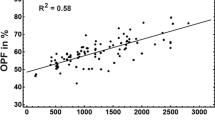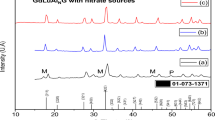Summary
The ESR spectrum of X-irradiated carbonated apatites precipitated from aqueous solutions was studied at carbonate contents ranging from approximately 5.4 up to 12.4 wt%. 12C- as well as 13C-enriched samples were prepared and examined with ESR after drying until constant weight at 25°C and 400°C. In these carbonated apatites, two CO3 3- radicals were detected, one of which is derived from B-type carbonate situated at a phosphate lattice site. The other CO3 3- most probably arises from CO3 2- ions situated at OH- lattice sites. In contradistinction to the B-type contribution, the A-type contribution to the overall ESR signal decreases in absolute terms with increasing carbonate concentration. In addition, the line shape and the complete set of principal g-values of the A1-signal found in previous studles could be determined, corroborating the assignment of A1 to a surface O- ion.
Similar content being viewed by others
References
Callens FJ, Verbeeck RMH, Matthys PFA, Martens LC, Boesman ER, Driessens FCM (1986) The ESR spectrum near g=2 of carbonated calciumapatites synthesized at high temperatures. Bull Soc Chim Belg 95:589–596
Callens FJ, Verbeeck RMH, Matthys PFA, Martens LC, Boesman ER (1987) 13C-hyperfine couplings of carbonate radicals in carbonated calciumapatites synthesized at high temperatures. Bull Soc Chim Belg 96:165–171
Callens FJ, Verbeeck RMH, Matthys PFA, Martens LC, Boesman ER (1987) The contribution of CO3 3- and CO2 - to the ESR spectrum near g=2 of powdered human tooth enamel. Calcif Tissue Int 41:124–129
Callens FJ, Verbeeck RMH, Naessens DE, Matthys PFA, Boesman ER (1989) Effect of carbonate content on the ESR spectrum near g=2 of carbonated calciumapatites synthesized from aqueous media. Calcif Tissue Int 44:114–124
Callens FJ, Verbeeck RMH, Naessens DE, Matthys PFA, Boesman ER (1991) The effect of carbonate content and drying temperature on the ESR spectrum near g=2 of carbonated calciumapatites synthesized from aqueous media. Calcif Tissue Int 48:249–259
Driessens FCM, Verbeeck RMH (1990) Biominerals. CRC Press, Boca Raton, FL
Meriaudeau P, Vedrine JC, Taarit YB, Naccache C (1975) Electron paramagnetic resonance studies of CO2 - radicals adsorbed on MgO. J Chem Soc Far Trans II 71:736–748
Mengeot M, Bartram RH, Gilliam OR (1975) Paramagnetic holelike defect in irradiated calciumhydroxyapatite single crystals. Phys Rev B 11:4110–4123
Horak M, Vitek A (1978) Interpretation and processing of vibrational spectra. John Wiley and Sons, Chichester
Rey C, Collins B, Goehl T, Dickson IR, Glimcher MJ (1989) The carbonate environment in bone mineral: a resolution-enhanced Fourier transform infrared spectroscopy study. Calcif Tissue Int 45:157–164
Author information
Authors and Affiliations
Additional information
Research Associate of the N.F.S.R. (Belgium)
Rights and permissions
About this article
Cite this article
Callens, F.J., Verbeeck, R.M.H., Naessens, D.E. et al. ESR study of 13C-enriched carbonated calciumapatites precipitated from aqueous solutions. Calcif Tissue Int 52, 386–391 (1993). https://doi.org/10.1007/BF00310204
Received:
Revised:
Issue Date:
DOI: https://doi.org/10.1007/BF00310204




